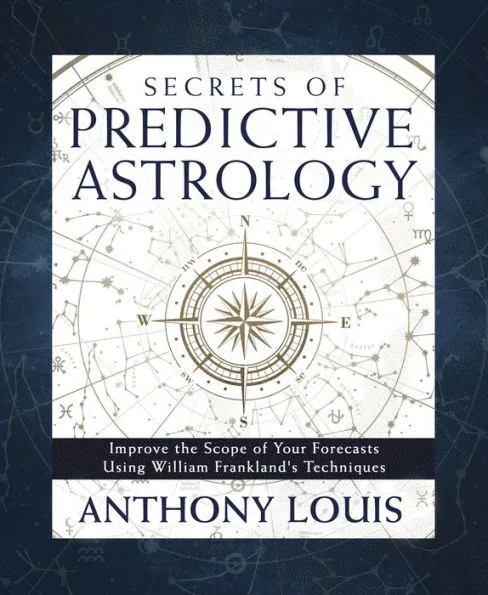When clients consult with an astrologer, they’ve got questions about all those squiggly symbols and connective lines printed out for them on a piece of paper: What does it all mean? They want to know what astrology has to say about their personalities, their talents and, most pressingly: What’s going to happen next? Most astrologers use astrology to forecast general trends and themes, rather than specific events. It’s like saying we’re now in a rainy season, versus warning that there will be thunder and lightning on the corner of 1st and Main on Wednesday at 4 p.m. The word “predictive,” though, is often used as a synonym for general forecasting.
Secrets of Predictive Astrology revives a set of forecasting techniques that were used by Wiliam Frankland, a London-based astrologer who had a thriving consulting practice in the 1920s and 1930s. Frankland’s methods received a few mentions in the writings of astrologers who came after him, but for the most part, his work had faded into obscurity. Now Anthony Louis, an impressive astrologer in his own right, has researched and tested Frankland’s methods and gives us this highly readable application of Frankland’s work from 100 years ago.
Anthony Louis is an M.D. psychiatrist based in Connecticut. He started practicing astrology when he was 11 years old—he’s in his late 70s now and gives his natal chart in the book-- back when there were few books available and you had to calculate a chart mathematically by hand. Louis is also a tarot scholar and a prolific author. His titles include Tarot, Plain and Simple and The Art of Forecasting Solar Returns. He also publishes an informative blog. Dr. Louis had a long-standing interest in the work of William Frankland, but it wasn’t until the pandemic shut-down year of 2021 that he had the time to immerse himself in Frankland’s work and to experiment with Frankland’s methods.
When we think of individual, horoscopic astrology, there’s the natal chart, the map of planetary alignments at the time of someone’s birth. But nothing remains static. Astrologers use various means to move a chart across time, to forecast what’s coming, and also to look retrospectively backward in time to understand what has already happened. One timing technique is to use transits, the angular configurations of moving planets in the sky at Time X, in relation to the planetary alignments in a birth chart. Other classic techniques include primary directions and secondary progressions which move a chart forward symbolically by looking at where the planetary alignments would be, by hour or day, after someone’s time of birth.
Transits, directions, and progressions are based on actual movements in the sky. Frankland called these “operative influences.” He also tested on his many clients a set of symbolic, mathematical techniques he called “new measures.” They weren’t all entirely new in that astrologers dating back at least as far as Claudius Ptolemy in the second century linked themes for each of the seven visible planets with specific spans of years in a person’s life.
Secrets of Predictive Astrology has a lot of math. It’s not insurmountable because the book is well written, there are plenty of tables with the math already calculated, and there are lots of celebrity charts used to teach the methods. This isn’t a book for beginning astrology students. It is definitely a book for anyone wanting to work with astrological timing.
Frankland’s hypothesis was that any major event in a life can be forecast by looking at a combination of transits, directions and/or progressions, the “operative influences,” accompanied by one or more of his symbolic ways of directing a chart. A major event will be apparent using multiple forecasting methods.
Dr. Louis’ opening chart example is a good test case. The birth chart of U.S. TV star Jennifer Aniston shows strong potential for unexpected relationship disruptions in her life. At first glance the chart gives no indication of when or what type of break-up(s) she’ll experience. There were major eclipses in 1978 that triggered her natal opposition between Venus and Uranus, and it’s known publicly that Aniston’s father abandoned the family when she was nine years old. Dr. Louis applies Frankland’s “new measures,” which show precisely that at the time of Aniston’s 9th birthday, there were triggers to the houses (areas of life) of Aniston’s birth chart representing parents, home and family life, and, specifically, the dissolution of matters signified by those houses.
The idea with symbolic measures, in tandem with transits, progressions, and directions, is to heighten the specificity of a forecast, as to times and areas of life to be impacted. It’s not about giving an (adult) astrology client a fatalistic sense of doom. It can be empowering for someone to think about how to take the high road and prepare, generally, for something on the future horizon.
One of the signs of astrology’s current renaissance is that there are now enough astrologically sophisticated readers that Llewellyn Publications has published this lengthy, advance astrology book. That may not have been the case not too long ago.
Beyond the utility of Frankland’s techniques, what I enjoy most about Anthony Louis’ book is that it’s an overdue tribute to a working astrologer from the past. Scholarship is most generous when it honors and builds on the work of those masters in the field who’ve come before. You can read Anthony Louis’ Secrets of Predictive Astrology to learn and practice timing methods. You can also read it as a fine example of astrology’s intellectual history.
~review by: Sara R. Diamond
Author: Anthony Louis
Llewellyn Publications, 2023
419 pp., $34.99

